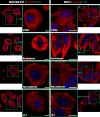G-1 Inhibits Breast Cancer Cell Growth via Targeting Colchicine-Binding Site of Tubulin to Interfere with Microtubule Assembly
- PMID: 28258163
- PMCID: PMC5457708
- DOI: 10.1158/1535-7163.MCT-16-0626
G-1 Inhibits Breast Cancer Cell Growth via Targeting Colchicine-Binding Site of Tubulin to Interfere with Microtubule Assembly
Abstract
G-protein-coupled estrogen receptor 1 (GPER1) has been reported to play a significant role in mediating the rapid estrogen actions in a wide range of normal and cancer cells. G-1 was initially developed as a selective agonist for GPER. However, the molecular mechanisms underlying the actions of G-1 are unknown, and recent studies report inconsistent effects of G-1 on the growth of breast cancer cells. By employing high-resolution laser scanning confocal microscopy and time-lapse imaging technology, as well as biochemical analyses, in the current study, we provide convincing in vitro and in vivo evidence that G-1 is able to suppress the growth of breast cancer cells independent of the expression status of GPERs and classic estrogen receptors. Interestingly, we found that triple-negative breast cancer cells (TNBC) are very sensitive to G-1 treatment. We found that G-1 arrested the cell cycle in the prophase of mitosis, leading to caspase activation and apoptosis of breast cancer cells. Our mechanistic studies indicated that G-1, similar to colchicine and 2-methoxyestradiol, binds to colchicine binding site on tubulin, inhibiting tubulin polymerization and subsequent assembly of normal mitotic spindle apparatus during breast cancer cell mitosis. Therefore, G-1 is a novel microtubule-targeting agent and could be a promising anti-microtubule drug for breast cancer treatment, especially for TNBC treatment. Mol Cancer Ther; 16(6); 1080-91. ©2017 AACR.
©2017 American Association for Cancer Research.
Conflict of interest statement
Figures






Similar articles
-
Tivantinib (ARQ 197) exhibits antitumor activity by directly interacting with tubulin and overcomes ABC transporter-mediated drug resistance.Mol Cancer Ther. 2014 Dec;13(12):2978-90. doi: 10.1158/1535-7163.MCT-14-0462. Epub 2014 Oct 13. Mol Cancer Ther. 2014. PMID: 25313010
-
The G protein-coupled oestrogen receptor 1 agonist G-1 disrupts endothelial cell microtubule structure in a receptor-independent manner.Mol Cell Biochem. 2012 Jul;366(1-2):239-49. doi: 10.1007/s11010-012-1301-3. Epub 2012 Mar 27. Mol Cell Biochem. 2012. PMID: 22451019
-
The Design, Synthesis, and Biological Activities of Pyrrole-Based Carboxamides: The Novel Tubulin Inhibitors Targeting the Colchicine-Binding Site.Molecules. 2021 Sep 24;26(19):5780. doi: 10.3390/molecules26195780. Molecules. 2021. PMID: 34641324 Free PMC article.
-
Microtubule Targeting Agents as Cancer Chemotherapeutics: An Overview of Molecular Hybrids as Stabilizing and Destabilizing Agents.Curr Top Med Chem. 2017;17(22):2523-2537. doi: 10.2174/1568026617666170104145640. Curr Top Med Chem. 2017. PMID: 28056738 Review.
-
Targeting Tubulin-colchicine Site for Cancer Therapy: Inhibitors, Antibody- Drug Conjugates and Degradation Agents.Curr Top Med Chem. 2019;19(15):1289-1304. doi: 10.2174/1568026619666190618130008. Curr Top Med Chem. 2019. PMID: 31210108 Review.
Cited by
-
The GPER Agonist LNS8801 Induces Mitotic Arrest and Apoptosis in Uveal Melanoma Cells.Cancer Res Commun. 2023 Apr 5;3(4):540-547. doi: 10.1158/2767-9764.CRC-22-0399. eCollection 2023 Apr. Cancer Res Commun. 2023. PMID: 37035582 Free PMC article.
-
Hyperactivated YAP1 is essential for sustainable progression of renal clear cell carcinoma.Oncogene. 2025 Jul;44(26):2142-2157. doi: 10.1038/s41388-025-03354-8. Epub 2025 Apr 10. Oncogene. 2025. PMID: 40210757
-
Suppressing Expression of SERPINE1/PAI1 Through Activation of GPER1 Reduces Progression of Vulvar Carcinoma.Cancer Genomics Proteomics. 2024 Nov-Dec;21(6):566-579. doi: 10.21873/cgp.20473. Cancer Genomics Proteomics. 2024. PMID: 39467628 Free PMC article.
-
Targeting the disrupted Hippo signaling to prevent neoplastic renal epithelial cell immune evasion.Nat Commun. 2025 Mar 24;16(1):2858. doi: 10.1038/s41467-025-57697-7. Nat Commun. 2025. PMID: 40128178 Free PMC article.
-
The G-Protein-Coupled Estrogen Receptor Agonist G-1 Mediates Antitumor Effects by Activating Apoptosis Pathways and Regulating Migration and Invasion in Cervical Cancer Cells.Cancers (Basel). 2024 Sep 27;16(19):3292. doi: 10.3390/cancers16193292. Cancers (Basel). 2024. PMID: 39409923 Free PMC article.
References
-
- Revankar CM, Cimino DF, Sklar LA, Arterburn JB, Prossnitz ER. A transmembrane intracellular estrogen receptor mediates rapid cell signaling. Science. 2005;307:1625–1630. - PubMed
-
- Bologa CG, Revankar CM, Young SM, Edwards BS, Arterburn JB, Kiselyov AS, et al. Virtual and biomolecular screening converge on a selective agonist for GPR30. Nat Chem Biol. 2006;2:207–212. - PubMed
-
- Albanito L, Madeo A, Lappano R, Vivacqua A, Rago V, Carpino A, et al. G protein-coupled receptor 30 (GPR30) mediates gene expression changes and growth response to 17beta-estradiol and selective GPR30 ligand G-1 in ovarian cancer cells. Cancer Res. 2007;67:1859–1866. - PubMed
Publication types
MeSH terms
Substances
Grants and funding
LinkOut - more resources
Full Text Sources
Other Literature Sources

